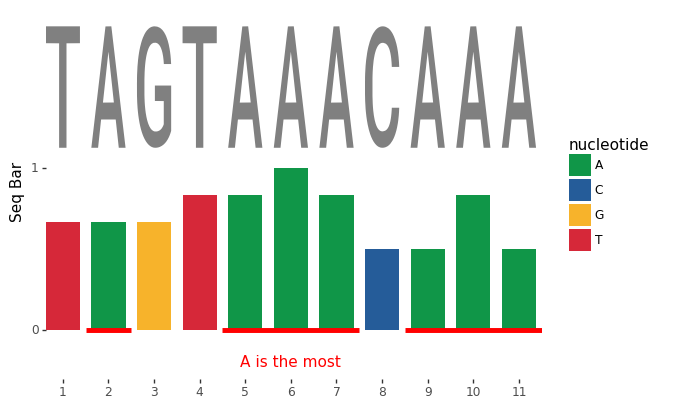Getting Started
Installation
pip install plotnineseqsuite
Load sample data
from plotnineseqsuite.data import seqs_dna, seqs_aa ,pfms_dna
This loads three sample data sets:
seqs_dna: dict of binding sites for 12 transcription factors obtained from FASTA files in JASPAR. The keys represent the JASPAR ID.pfms_dna: dict of position frequency matrices for four transcription factors obtained from JASPAR. The keys names represent the JASPAR ID.seqs_aa: dict of kinase-substrate phosphorylation sites obtained from Wagih et al. The keys represent the names of the kinases associated with the phosphosites.
Visualizing aligned sequences
Plot an aligned sequences
You can draw an aligned sequences using ggplot function, with geom_alignedSeq. Let’s try this on sequences for one of the transcription factors from JASPAR:
from plotnine import ggplot, coord_fixed
from plotnineseqsuite.align import geom_alignedSeq
from plotnineseqsuite.theme import theme_seq
ggplot() + geom_alignedSeq(seqs_dna['MA0013.1']) + theme_seq() + coord_fixed()

Accepted input formats
geom_alignedSeq accepts two types of input, each described in detail below
- list: a list of aligned sequences
- dict: It is used for plotting more than one sequence logo at the same time with the help of facets, the key of dict is facet value, and the value of dict is list described above
No background color
When col_scheme option is None, the picture has no background color.
ggplot() + geom_alignedSeq(seqs_dna['MA0013.1'], no_scheme_col='black', col_scheme=None) + theme_seq() + coord_fixed()

No sequence letter
When font option is None and border_col is None, the picture has only the background color.
ggplot() + geom_alignedSeq(seqs_dna['MA0013.1'], font=None, border_col=None) + theme_seq() + coord_fixed()
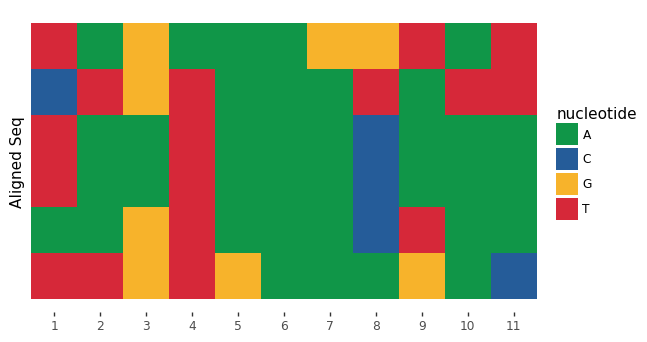
The color scheme switches to letters
When the option scheme_applied is LETTER, the color scheme will be applied from the background to the letters.
ggplot() + geom_alignedSeq(seqs_dna['MA0013.1'], no_scheme_col='white', scheme_applied='LETTER') + theme_seq() + coord_fixed()

Tagging sequences
You can set seq_names parameter to identify the name of the sequence.
names=['seq-a', 'seq-b', 'seq-c', 'seq-d', 'seq-e', 'seq-f']
ggplot() + geom_alignedSeq(seqs_dna['MA0013.1'], seq_names=names) + theme_seq() + coord_fixed()

Visualizing sequence logo
Plot a sequence logo
You can draw a sequence logos using ggplot function, with geom_logo. Let’s try this on sequences for one of the transcription factors from JASPAR:
from plotnine import ggplot
from plotnineseqsuite.logo import geom_logo
from plotnineseqsuite.theme import theme_seq
ggplot() + geom_logo(seqs_dna['MA0001.1']) + theme_seq()

Accepted input formats
geom_logo accepts three types of input, each described in detail below
- list: a list of aligned sequences
- numpy.ndarray: a position frequency matrix, where the row is the letter, and column is the position. Note: The order of the rows corresponds to the NAMESPACE one by one.
- dict: It is used for plotting more than one sequence logo at the same time with the help of facets, the key of dict is facet value, and the value of dict is list or numpy.ndarray described above
The following generates a sequence logo using a position frequency matrix from the sample data
ggplot() + geom_logo(pfms_dna['MA0018.2'],seq_type='DNA') + theme_seq()

Plotting methods
geom_logo supports two sequence logo methods through the method options: ‘bits’ and ‘probability’. By default, the bits is used.
ggplot() + geom_logo( seqs_dna['MA0001.1'], method = 'bits' ) + theme_seq()
ggplot() + geom_logo( seqs_dna['MA0001.1'], method = 'probability' ) + theme_seq()
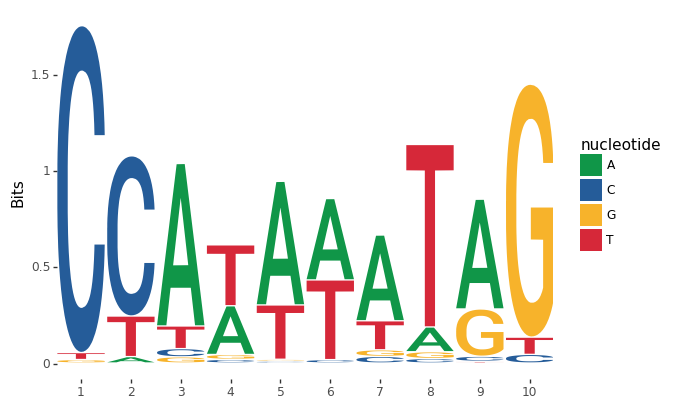

Custom-height logos
If you have your own height metric for each letter, simply create a matrix where each cell is a the desired height, and set the method to custom. You can even have negative heights. Here’s a simple example:
import numpy as np
custom_mat = np.random.randn(4,5)
ggplot() + geom_logo(custom_mat, method='custom', seq_type='DNA') + theme_seq()
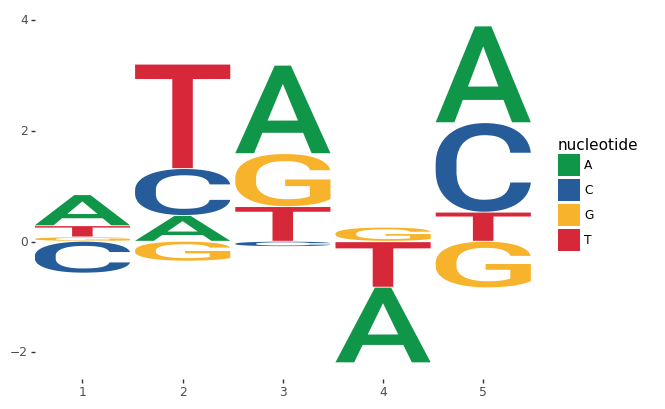
Visualizing sequence histogram
Plot a sequence histogram
You can draw a conservation bar of aligned sequences using ggplot function, with geom_seqBar. Let’s try this on sequences for one of the transcription factors from JASPAR:
from plotnineseqsuite.bar import geom_seqBar
ggplot() + geom_seqBar(seqs_dna['MA0013.1']) + theme_seq()

Accepted input formats
geom_seqBar accepts three types of input, each described in detail below
- list: a list of aligned sequences
- numpy.ndarray: a position frequency matrix, where the row is the letter, and column is the position. Note: The order of the rows corresponds to the NAMESPACE one by one.
- dict: It is used for plotting more than one sequence histogram at the same time with the help of facets, the key of dict is facet value, and the value of dict is list or numpy.ndarray described above
The following generates a sequence histogram using a position frequency matrix from the sample data
ggplot() + geom_seqBar(pfms_dna['MA0018.2'],seq_type='DNA') + theme_seq()
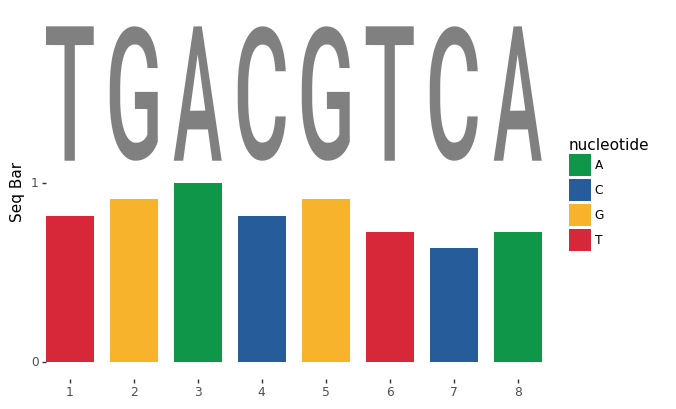
No sequence letter
When font option is None, the picture has only the bar.
ggplot() + geom_seqBar(seqs_dna['MA0013.1'], font=None) + theme_seq()

Sequence types
Preset alphabets
Amino acids, DNA and RNA sequence types are all supported by geom_logo, geom_seqBar and geom_alignedSeq. By default, plotnineSeqSuite will try to guess your sequence type. You can explicitly set the sequence type through the seq_type option.
Lets try generate an amino acid sequence logo using kinase-substrate phosphorylation data:
ggplot() + geom_logo( seqs_aa['AKT1'], seq_type = 'AA' ) + theme_seq()
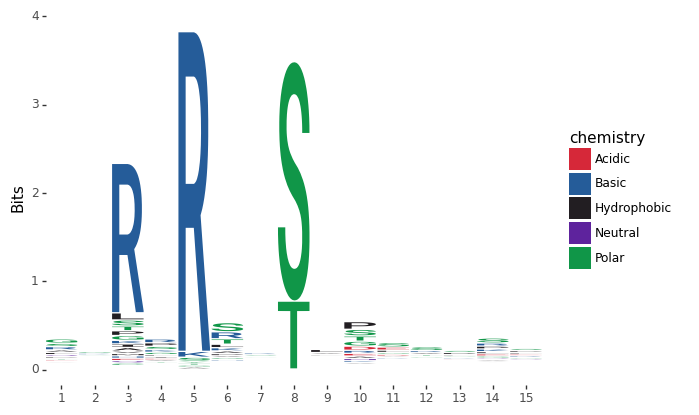
Custom alphabet
If you want to define a custom alphabet you can do so by setting namespace with your desired custom alphabet. For example, lets say you wanted a sequence logo of zeros and ones:
from plotnine.guides import guides
seqs_numeric = list(map(lambda x: x.replace('A','1').replace('T','2').replace('G','3').replace('C','4'), seqs_dna['MA0001.1']))
ggplot() + geom_logo(seqs_numeric, method='probability', namespace=['1','2','3','4']) + theme_seq()+guides(fill=False)
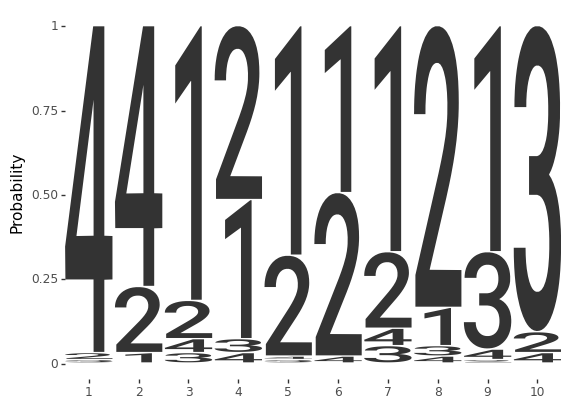
Greek letters are also supported:
seqs_numeric = list(map(lambda x: x.replace('A','δ').replace('T','ε').replace('G','ψ').replace('C','λ'), seqs_dna['MA0001.1']))
ggplot() + geom_logo(seqs_numeric, method='probability', namespace=['δ','ε','ψ','λ']) + theme_seq()+guides(fill=False)

Colour schemes
Preset color schemes
plotnineSeqSuite has preset color schemes that can be set using the col_scheme parameter in geom_logo, the parameter bar_col_scheme in geom_seqBar and the parameter col_scheme in geom_alignedSeq. By default, the col_scheme is set to AUTO such that the color scheme is automatically chosen based on your sequence type.
Lets try generate an amino acid sequence logo using kinase-substrate phosphorylation data:
ggplot() + geom_logo(seqs_dna['MA0001.1'], col_scheme='base_pairing') + theme_seq()

Custom color schemes
If the presets are not enough for you, you can define custom discrete or continuous color schemes using the col_schemes.make_col_scheme function. Here are two examples of discrete and continuous color schemes.
Discrete color schemes
from plotnineseqsuite.col_schemes import make_col_scheme
cs1 = make_col_scheme(chars=['A', 'T', 'C', 'G'], groups=['gr1', 'gr1', 'gr2', 'gr2'],cols=['purple', 'purple', 'blue', 'blue'])
ggplot() + geom_logo(seqs_dna['MA0001.1'], col_scheme=cs1) + theme_seq()
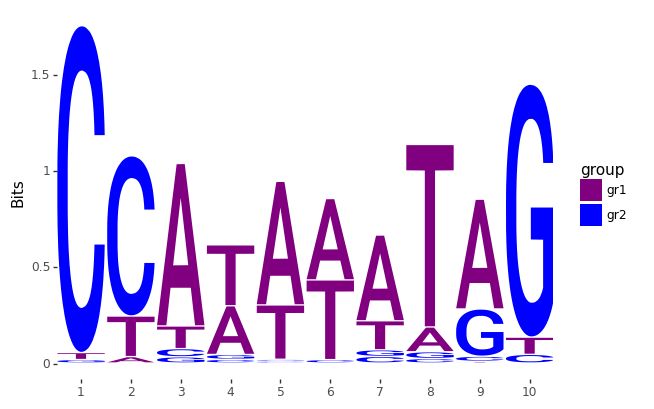
Continuous color schemes
cs2 = make_col_scheme(chars=['A', 'T', 'C', 'G'], values=[1,2,3,4])
ggplot() + geom_logo(seqs_dna['MA0001.1'], col_scheme=cs2) + theme_seq()
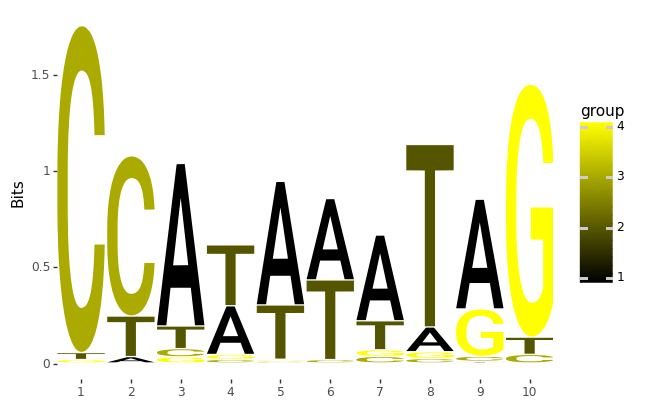
Multiple grouped sequences
You can plot more than one grouped sequences at the same time with the help of facets. plotnineSeqSuite will accept a dict. The keys of the dict will be used as the facet titles. Take geom_logo for example.
from plotnine import facet_wrap
ggplot() + geom_logo(seqs_dna)+ theme_seq()+facet_wrap('~seq_group', ncol=4, scales='free_x')

Fonts
You can adjust the font of letters by setting the font parameter. To list all the available color schemes use the font.list_fonts function. Take geom_logo for example.
from plotnine import ggtitle
from plotnineseqsuite.font import list_fonts
fonts = list_fonts()
for i in range(0, 15, 3):
print(ggplot() + geom_logo(data=seqs_dna['MA0001.1'], font=fonts[i]) + theme_seq() + ggtitle(fonts[i]))
print(ggplot() + geom_logo(data=seqs_dna['MA0001.1'], font=fonts[i + 1]) + theme_seq() + ggtitle(fonts[i + 1]))
print(ggplot() + geom_logo(data=seqs_dna['MA0001.1'], font=fonts[i + 2]) + theme_seq() + ggtitle(fonts[i + 2]))

Advanced plotnineSeqSuite
plotnineSeqSuite is based on object-oriented design. The *_data property of class geom_logo and geom_seqBar, geom_alignedSeq is a core feature.
Combining plots
Without using any packages like patchwork and cowplot, plotnineSeqSuite can easily plot geom_logo and geom_seqBar, geom_alignedSeq in one figure. I’ll demonstrate with an example plotting probability sequence logo, aligned sequences and sequence histogram in one figure via changed *_data property.
from plotnine import scale_y_continuous
names = ['seq-a', 'seq-b', 'seq-c', 'seq-d', 'seq-e', 'seq-f']
seqs = geom_alignedSeq(seqs_dna['MA0013.1'], seq_names=names)
logo = geom_logo(seqs_dna['MA0013.1'], method='probability')
logo.data['y'] = logo.data['y']+6.1
bar = geom_seqBar(seqs_dna['MA0013.1'], font=None)
bar.bar_data['y'] = bar.bar_data['y'] - 6.1
ggplot() + logo + bar + seqs + theme_seq() + scale_y_continuous(breaks=lambda x: [k + 0.5 for k in range(0, len(names))], labels=names)

Modify the starting position
When the input sequence fragment does not start at 1, you can modify the x value of the property to display the correct starting position.
names = ['seq-a', 'seq-b', 'seq-c', 'seq-d', 'seq-e', 'seq-f']
seqs = geom_alignedSeq(seqs_dna['MA0013.1'], seq_names=names)
seqs.bg_data['x'] = seqs.bg_data['x']+3333
seqs.letter_data['x'] = seqs.letter_data['x']+3333
ggplot() + seqs + theme_seq()

Used concurrently with other functions of plotnine.
Because plotnineSeqSuite is an extension of plotnine, functions of plotnine can be used without obstacles. Here is an example of drawing rectangles, lines and text.
from plotnine.geoms import annotate
ggplot() + geom_alignedSeq(seqs_dna['MA0013.1']) + annotate('rect', xmin=0.5, xmax=3.5, ymin=-0.05, ymax=6.1,alpha=.1, color='black') + theme_seq()
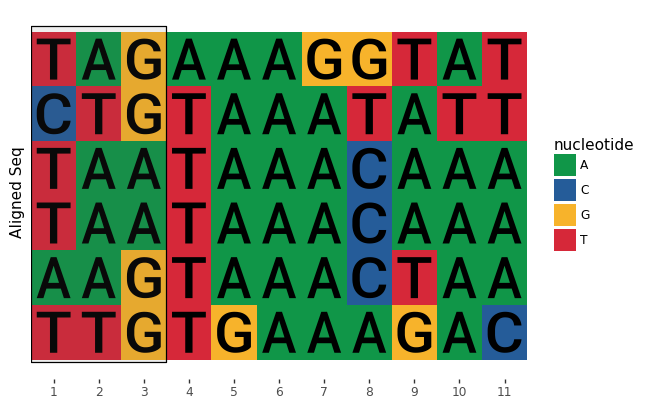
ggplot() + geom_seqBar(seqs_dna['MA0013.1']) + annotate('segment', x=1.5, xend=2.5, y=0, yend=0, size=2, color='red') + annotate('segment', x=4.5, xend=7.5, y=0, yend=0, size=2, color='red') + annotate('segment', x=8.5, xend=11.5, y=0, yend=0,size=2, color='red') + annotate('text', x=6, y=-0.2,label='A is the most', color='red') + theme_seq()
